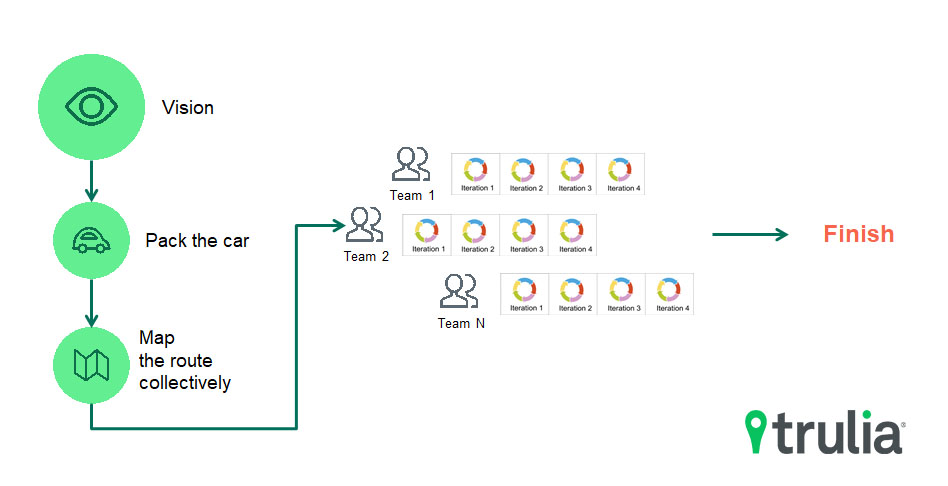Launching a massive cross-team project on time is an obstacle most companies struggle with. The answer isn’t always having the best technology or resources, it’s simply having good communication.
Clear, concise communication is the first step in rallying large teams to achieve a shared goal, and it’s how Trulia coordinated fifteen different engineering teams to work together in sync to launch a critical project in a very aggressive timeline.
Let’s have a look at how we navigated this journey:

Step One: Packing the Car
Like any big project, the first step is getting all stakeholders on board by communicating the project vision, goals, and objectives. We leveraged the RACI (Responsible, Accountable, Consulted, Informed) model to identify project stakeholders and their roles. In this case, the product manager was responsible for defining the project goal, engineering teams were responsible for defining the path to reach those targets, and the program manager was responsible for driving the project forward and keeping everyone on track. You might have guessed, but those consulted or informed were Trulia executives or any other managers who needed to be kept in the know, or who could provide value throughout the project. Once we knew the stakeholders, we hosted a feature kick-off to communicate project goals.
Focusing on communication in this first step helped ensure clear ownership and resulted in less duplicated efforts. It also gave us power to know when to involve people.
Step Two: Mapping the Route
We had the answer for who was going to work on this project, but the road ahead was still blurry – there were multiple routes that would lead us to our destination, and we needed to decide which to take.
We asked all 15 engineering teams to collaborate and suggest options to solve the problem. Instead of choosing the quickest solution, we chose the one that would not create more tech debt for us. After, we asked each team to give us an estimation of how much time they needed to complete their task. The key to accurately estimating time is having a clear and concise goal that everyone understands, as is opening the lines of communication between product and engineering.
After estimates were shared and the schema defined, there was negotiation and discussion about timing and scope between product and engineering. Allowing for this discussion to happen is mission critical. If you don’t have the two groups talking, working with each other, and agreeing on timing and goals, your project won’t be successful.
After the negotiations, everyone was aligned and we built our project plan. Defining the execution strategy together helped us see the big picture, and ensured teams worked in parallel paths to prevent blocking each other.
Step Three: Hitting the Gas Pedal
By now, we had a plan, and it was time to start executing. To kick things off, we made the plan visible to all stakeholders via an internal project dashboard. Each team managed their own tasks and details, but we tracked high-level milestones and touch points between the different teams at a cross-team level. To be successful with a project of this size, it’s important for program managers to create an environment for people to communicate on their own, outside of the scheduled meetings and ongoing dashboards. Continuous communication throughout this phase helped us keep the project on track and create an environment with no surprises.
Step Four: Reaching the Destination
Finally, we were two weeks away from launch! Each team’s work was complete, but we had bugs with no clear team owner. Weekly team-based status update meetings were not enough, so we started daily cross-team meetings that were focused on end-to-end testing. Blocker bugs were made visible along with clear owner(s), and teams collectively crushed them. When we approached release day, our board was clean of all blocker bugs and we released a massive project ON TIME!
The last few weeks of every complex cross-team project are most critical. Strong communication at this step helped us to move fast. Your journey shouldn’t stop there either. Once your product is launched, it’s still important for stakeholders to discuss learnings and successes, so you can maximize the next project.
Next time you’re planning a high-priority cross-team initiative, my hope is that this post can help inspire your approach.


